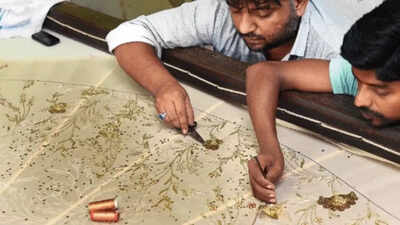ARTICLE AD BOX

No journey through Lucknow’s heritage is complete without immersing oneself into the grandeur of zardozi , the exquisite embroidery that once adorned the robes of monarchs.A glittering dance of gold and silver threads, precious stones and velvet fabrics, zardozi is not just embroidery—it’s royal storytelling, stitched by hand.
In the quiet courtyards and old workshops of Lucknow, this majestic craft continues to thrive, bridging centuries of Mughal splendour with today’s couture dreams.

Derived from the Persian word ‘ zardozi ’, meaning embroidery with gold and silver threads, this art form involves using metallic threads along with pearls, beads and precious stones on rich fabrics like silk and velvet. Unlike everyday embroidery styles like Japanese sashiko, Indian kantha , or Mexican Otomi, which are often flat and symbolic, zardozi is elaborate and three-dimensional.
It uses a technique called couching, where thick metallic threads are laid on the fabric and stitched down with finer threads, creating a sculpted, luxurious texture.Anthropologist Nadeem Hasnain noted that: “ Zardozi reached artistic heights in Lucknow during the nawabi era, with intricate and fine motifs introduced to suit the refined aesthetic of the region. Techniques like kamdani , zari and karchaub are important elements of this craft.”
Hasnain also pointed out that while most chikan artisans in Lucknow are Sunni Muslims, zardozi workers have historically been Shias.History professor Dr Sanobar Haider says: “ Zardozi is believed to have been brought to India from Persia by Empress Noor Jahan. The artisans, known as zardoz , work on a wooden frame called an adda , seated on the ground and using a hooked needle resembling a pen. One legendary zardoz , Makka Darzi, was the personal designer to Nawab Naseeruddin Haider.
Known for blending European fashion with traditional zardozi , he once created a cap from leftover fabric that impressed the nawab so much that he gifted a plot to him.
”A zardoz , Sameer Khan from Chowk Satkhanda, outlines the process: The design, often inspired by Mughal, floral, or geometric motifs, is first sketched, then perforated onto tracing paper and stamped on the fabric using chalk and kerosene.Silk, velvet, or satin is stretched tightly over the adda . Materials like zari threads, dabka (coiled wire), salma (metal spirals), sitara (sequins), pearls, and beads are used. Techniques like aari and dabka create raised patterns. Once complete, the cloth is steamed, cleaned and trimmed. Zardozi features prominently in bridal wear, sherwani s, saree s and home décor.Though historically maledominated, a few women have taken up the craft in recent years. Names like Ameer Husain (Khala Bazar), Taqi Husain (Balochpura), Haider Husain (Sheesh Mahal) and Saleem Khan (Gadhi Peer Khan) are still remembered as masters.
Zardozi is more than just intricate embroidery—it’s a living heritage. Woven into each glinting thread is the royal legacy of Lucknow, echoing the grandeur of bygone eras. This centuries-old craft is kept alive by master artisans whose every stitch breathes history into fabric, transforming cloth into timeless works of art. As poetry so eloquently captures:Stitched on screenTill the 1950s, Zardozi remained local to Lucknow. In the 1960s, it gained wider exposure, especially through Bollywood filmsMughal-e-Azam (1960): Although made decades ago, the film featured costumes with hand-done embroidery resembling early forms of Zardozi — elaborate and rich, especially for Anarkali (Madhubala)Jodhaa Akbar (2008): Aishwarya Rai’s elaborate lehengas and Anarkalis were richly adorned with Zardozi work, reflecting Rajputana royalty. Hrithik Roshan’s costumes as Akbar also featured Zardozi on jamas and angarkhasPadmaavat (2018): Deepika Padukone’s outfits as Queen Padmavati used intricate Zardozi embroidery with Mughal and Rajput motifs. Heavy gold and silver threadwork added realism and gravitas to royal court scenes



.png)
.png)
.png)
















 3 days ago
4
3 days ago
4







 English (US) ·
English (US) ·